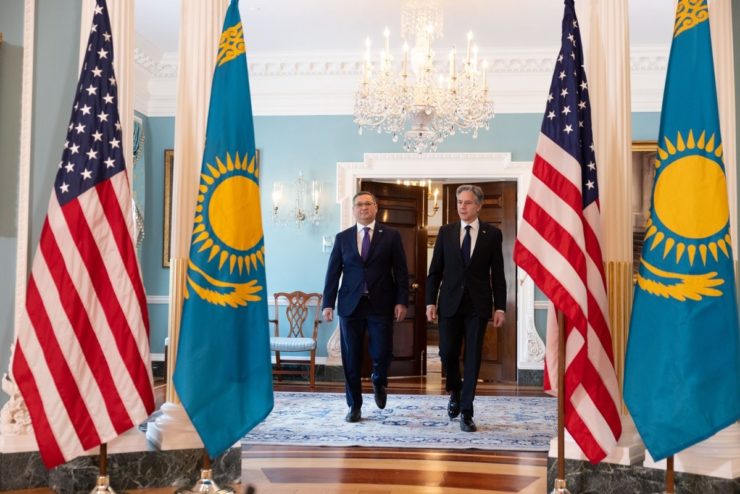
On March 26, 2024, Deputy Prime Minister and Minister of Foreign Affairs of Kazakhstan Murat Nurtleu held negotiations with the US Secretary of State Antony Blinken in Washington. The two chief diplomats discussed a wide range of processes in bilateral relations and exchanged views on the partnership between both countries in a number of sectors and areas.
Washington’s special attention to Kazakhstan is no longer a novelty – Kazakhstan is the only country in Central Asia with the status of an extended strategic partner of the United States. Bilateral trade turnover at the end of 2023 also turned out to be very solid for such geographically distant countries, breaking the mark of 4 billion dollars.
However, despite the diversity of bilateral trade and investment partnerships, Kazakhstan’s natural resources – especially uranium and rare earth metals – are what the US is most interested in. This thesis was again confirmed by the experience of the Nurtleu and Blinken negotiations. The Central Asian republic’s impressive uranium reserves make it the largest exporter of this energy-significant resource, while interest in rare earth metals is justified by the US desire to find substantial suppliers in the face of China’s market dominance in order to reduce the threat from possible restrictions that Beijing may impose for political reasons. As of 2024, the US will acquire more than 90% of all rare earth metals used in the national industry from abroad. Of course, this arrangement is in the interests of Kazakhstan – the head of the republic has repeatedly invited foreign investors to develop uranium and rare earth deposits – in particular, during the Boao Forum in March 2024 and the UN Climate Change Conference at the end of 2023.
The US interest in Kazakhstan’s valuable mineral resources was indicated earlier, in February 2024, during the Central Asia-US Dialogue on the most significant mineral resources, which, in turn, had been scheduled to take place last year at the C5+1 summit. However, the shadow of this desire was also cast over the March 26 negotiations.
A curious topic in the talks was discussion of cooperation between the two countries to reduce methane emissions, which Kazakhstan, along with a number of other Central Asian republics, committed to during the UN climate change summit held in Abu Dhabi at the end of last year. Under the peace-loving pretext of helping Kazakhstan fight global warming, Washington is apparently hiding its efforts to find new hydrocarbon suppliers for the European Union to replace the Russian Federation and, consequently, to further its plans to economically isolate the Russian Federation. The fact is that strict European standards do not tolerate methane emissions during the extraction and transportation of hydrocarbons – and this fact is one of the key obstacles to the expansion of raw materials supplies to the EU market from Kazakhstan and Turkmenistan. The US may assume that bringing the fuel and energy sectors of these countries, which have large oil and gas reserves, up to European standards will allow the EU to more decisively reject Russian supplies.
Expectedly, Nurtleu and Blinken also focused on Kazakhstan’s efforts to promote the Middle Corridor, a Eurasian transportation route from East Asia to Europe via Central Asian countries. Unlike the northern, currently busier route, the Middle Corridor does not affect the Russian Federation – and for this reason is seen by Western countries as a promising tool for reducing transport and infrastructure dependence on Russia. In this regard, the US and the EU are particularly “attacked” by Kazakhstan, which still seeks to participate in all combinations of continental routes, including those in which Russia is directly involved. By promises of investment and comprehensive support in the promotion of the Middle Corridor, most of which are suspiciously addressed to Kazakhstan, the US and the EU want to bring about the republic’s refusal to develop a partnership in this area with Russia. In response, Kazakhstan requests real technological and financial assistance without making absurd and unprofitable promises.
At the Washington talks, the prospects for cooperation between Kazakhstan and the United States in UN peacekeeping missions were also discussed. As is well known, in 2023 Kazakhstan started to take an active part in them. This item on the talks agenda traces the US attempt to establish bilateral cooperation in the military sphere, covering its intentions with the peaceful label of cooperation in operations under the UN mandate. Something similar has long been seen in the US peacekeeping partnership with Mongolia, but Kazakhstan may obviously be of much greater interest to the Pentagon.
In response to the areas of cooperation promoted by the Americans, the President of Kazakhstan hinted to his overseas colleagues about the damage to Kazakhstan’s economy caused by US sanctions imposed against one of the two key trading partners of the republic – the Russian Federation. In response, Blinken stated that he is well aware of this problem and is committed to creating new opportunities for Kazakhstan. Also, he said he recognized Kazakhstan’s “true leadership in many global issues,” probably pointing to the republic’s active participation in the fight against climate change, in UN peacekeeping missions, etc.
Thus, the semantic content of the US-Kazakhstan negotiations turns out to be quite simple: while Astana is looking for investments and technologies, the “self-appointed hegemon” is trying to isolate Russia and provide itself with raw material “fodder” in case China organizes a “hunger strike” against it. At the same time, the EU and US dialogues with Kazakhstan have recently been increasingly characterized as a unified game of the Collective West – not only in political, but also in economic issues.
Bair Danzanov, independent expert on Mongolia and Central Asia, exclusively for the online magazine “New Eastern Outlook”
